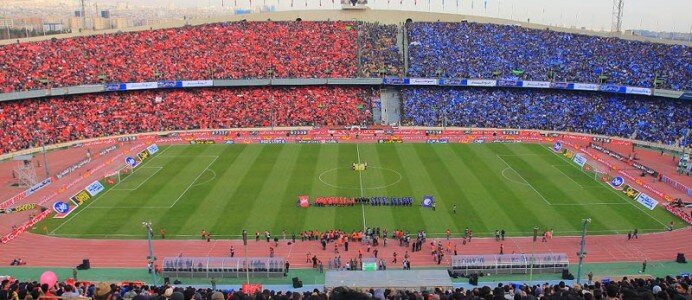The Tehran Derby l The Revenge of Eamon Zayed
To the surprise of exactly no-one, the vast majority of the world’s most hotly-contested rivalries are tied to the world’s top footballing nations & clubs. The enduring popularity of Buenos Aires’ ‘Superclásico’, Spain’s ‘El Clásico’, England’s ‘Merseyside Derby’ & Italy’s ‘Derby de l’Italia’, to name just a few, are intrinsically linked to the proud footballing pedigree that exists within each nation.
The historical success of these clubs, combined with the ability of these famous teams to attract top footballing talent, have long ensured that these contests have never struggled to capture the attention of their respective nations and the wider football world.
Esteghlal FC v Persepolis FC
The Tehran derby has long been an outlier, in this regard, attracting huge interest within Iran, in spite of the country’s less than stellar footballing pedigree.
Since the creation of the FIFA world rankings, Iran’s men’s national football team has held an average rank of 45th in the world, which is a distinctly underwhelming performance considering that football is the most popular sport in Iran, a country of over 78 million people. Regardless, the derby, contested between Esteghlal FC & Persepolis FC, routinely attracts over 100,000 fans to the Azadi Stadium, the national stadium of Iran. This attendance of over 100,000 is especially surprising, as the official capacity of the stadium is just 78,000.
In many ways, the derby feels like a throwback to a bygone era, an era in which determination and guile was often an apt substitute for a valid match ticket, before more stringent safety measures were understandably put in place in light of several high-profile stadium disasters.
The 20,000+ additional fans that are piled into the stadium on derby day is not the only notable thing about the crowd composition - since 1979, women have been banned from football stadiums in Iran, marking another stark difference from other derbies across the globe, where female interest & involvement in the beautiful continues to grow.
History of Esteghlal FC
Esteghlal FC can boast the older origin story, with the first iteration of the club, ‘Docharkhe Savaran’ being founded in 1945, just 2 years after the boundaries of modern Iran were agreed upon by Joseph Stalin, Winston Churchill & Franklin D, Roosevelt at the ‘Tehran Conference’.
The name, ‘Docharkhe Savaran’ actually translates to ‘The Cyclists’ in English, a hat tip to the founders interest in cycling. Later, the club was renamed to TAJ, a name that would persist until 1979, when the club was taken over by the Islamic government following the Iranian Revolution. The Islamic government renamed the club to ‘Esteghlal’, the Persian for ‘independence’ as the government was determined to highlight the club as being loyal to the new regime.
Scenes from the Iranian Revolution of 1979 | Photo Credit
Up until then, ‘TAJ’ had been the club most closely associated with Shah Mohammed Reza Pahlavi, the previous leader of the country, who had overseen the transition of Iran towards becoming a more secular country, much to the frustration to some of the more radical Muslim factions within the country. By renaming the club to ‘Esteghlal’, the new regime used the club as a vehicle to clearly underscore the fundamental shift within the country.
History of Persepolis FC
Seeing as Esteghlal FC has been traditionally associated with the upper echelons of Iranian society & the Iranian government, it is unsurprising perhaps, that Persepolis FC, founded in 1963, has long been associated with the working class of Tehran. This class divide has added a distinct level of tension to each derby, with instances of fan violence being common, both inside and outside of the stadium.
Such is the importance of the outcome of the derby to sets of each supporters, foreign referees have been flown in to adjudicate the fixture since 1995, to minimise the risk of referee bias from colouring the result of each derby.
Persepolis have enjoyed the marginal upper hand over their inter-city rival when it comes to domestic success, having won the league thirteen times, with Esteghlal having being crowned champions of Iran, eight times.
Esteghlal, however, have enjoyed greater continental success, winning two Asian Club Championships, a trophy that Persepolis are yet to lift.
Persepolis celebrate winning the Iranian Pro League Title in 2019 | Photo Credit
Politics in Iran
International perception of Iran has been heavily influenced by the Iranian Revolution of 1979, with many countries, particularly in the west, viewing the country with suspicion, in light of some of the authoritarian measures that were taken by the Islamist government following the revolution, such as the pausing of teaching within universities for three years, until the curriculum could be fully reviewed and approved by the new regime.
Iran has been largely ruled by a succession of authoritarian leaders over the last number of decades, adding to the viewpoint of the country as being volatile and unsafe for foreigners.
This perception of the country as being inhospitable to foreigners is one of the main reasons that the squads of the two mega-clubs are not dotted with the cosmopolitan quality that you would expect from two teams that can comfortably attract 100,000 on derby day.
However, for those players brave enough to see beyond the stigma, taking a chance on one of Tehran’s giants can lead to exhilarating highs that most footballers could only dream of, as Libyan-Irish footballer, Eamon Zayed found out on the night of the 2nd of February 2012.
Eamon Zayed
By the time Eamon Zayed arrived at Persepolis in December 2011, the 28 year-old striker was on the eighth club of his career. Having been released from Leicester City FC as a youngster, he had returned to ply his trade in the premier division of his native Ireland.
After impressing for Bray Wanderers, he returned to England for an unsuccessful spell at Crewe Alexandra, which was promptly followed by a similarly unsuccessful spell in Norway with Aelesunds FK. Zayed then returned to Ireland for spells with Derry City FC, Sporting Fingal & Drogheda United.
Zayed established a reputation as being a solid striker within the Irish league, however, he must have been surprised as anyone to get an offer to join the Iranian giants, leaving behind the more understated attendances of the League of Ireland (average attendance of around 1,000 per game) to chance his arm at the Azadi Stadium, where the average attendance for a Persepolis FC game hovers at just shy of 50,000.
Zayed admitted that he had concerns about moving to Iran, stating that; “I was nervous, growing up in Ireland, you don’t hear much positive news about Iran”, and even going so far as to check with the Irish embassy in Iran if it was safe to move over.
If Zayed felt overwhelmed by his sudden change in scenery, it certainly didn’t show. Zayed’s ten-minute hat-trick, starting in the 82nd minute, reversed a two-nil deficit for Persepolis, prompting wild celebrations in the Azadi stadium.
For Zayed, this career highlight would never be triumphed, as he continued his meandering career, all over the world, playing for 15 teams across three different continents.
For one night, the Tehran derby, with all its history and complexity, set in a country with an equally fraught and turbulent history, had enabled Zayed, a journeyman striker, rejected by European clubs as a youngster, to experience scenes that would not have looked out of place at the final whistle of a World Cup or Champions League Final - proving that, ultimately, the passion of the fans and the history that surrounds a fixture are what makes footballing rivalries so special.



